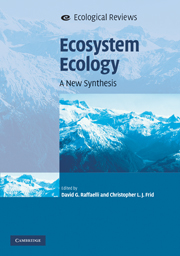Book contents
- Frontmatter
- Contents
- List of contributors
- Preface
- 1 The evolution of ecosystem ecology
- 2 Linking population, community and ecosystem ecology within mainstream ecology
- 3 Thermodynamic approaches to ecosystem behaviour: fundamental principles with case studies from forest succession and management
- 4 Ecosystem health
- 5 Interdisciplinarity in ecosystems research: developing social robustness in environmental science
- 6 The links between biodiversity, ecosystem services and human well-being
- 7 Ecosystem ecology and environmental management
- Index
- References
4 - Ecosystem health
Published online by Cambridge University Press: 05 June 2012
- Frontmatter
- Contents
- List of contributors
- Preface
- 1 The evolution of ecosystem ecology
- 2 Linking population, community and ecosystem ecology within mainstream ecology
- 3 Thermodynamic approaches to ecosystem behaviour: fundamental principles with case studies from forest succession and management
- 4 Ecosystem health
- 5 Interdisciplinarity in ecosystems research: developing social robustness in environmental science
- 6 The links between biodiversity, ecosystem services and human well-being
- 7 Ecosystem ecology and environmental management
- Index
- References
Summary
Introduction: origins and development of the ecosystem health concept
The need to understand and quantify ecosystem behaviour and condition has come to the forefront of environmental policy due to a greater emphasis on environmental sustainability and an accompanying recognition of the scarcity of natural resources, such as water, soil and biological diversity. Increasing concern regarding human impacts on the environment and the possibility that some human-induced changes in ecological systems may be irreversible has also focused attention on ways in which such changes can be assessed and, if possible, avoided. From the policy maker's perspective, the concern is not only in terms of the possible extent of these problems, but also the likelihood of their occurrence and the timeframe over which they may operate. In the context of global climate change, understanding the functioning of ecosystems, and how their health and performance can be measured and monitored over time are of critical importance, since these are linked inextricably with human health and well-being.
A considerable body of literature over the past decade has sought to define ecosystem health in practical terms. The majority of the definitions of ecosystem health concentrates exclusively on ecological aspects. For example, Costanza (1992) defines the term as follows: ‘An ecological system is healthy and free from “distress syndrome” if it is stable and sustainable – that is, if it is active and maintains its organisation and autonomy over time and is resilient to stress.’
- Type
- Chapter
- Information
- Ecosystem EcologyA New Synthesis, pp. 65 - 93Publisher: Cambridge University PressPrint publication year: 2010
References
- 3
- Cited by



